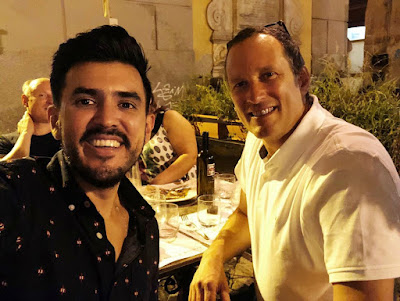Hello word...!!
As promised before,
I am trying to catch up with you therefore, this time I am writing about the summer
school we, SMARTI-Fellows, had in gorgeous Palermo during the first week of
September last year. For those who have been reading my blog since the
beginning will know that SMARTI is the acronym for “Sustainable Multi-functional
Automated Resilient Transport Infrastructure” right? For those who did not know
then I kindly invite you to click on the next link where you will find about our projects
and our dissemination activities 😊.
Figure 1: SMARTI ETN Summer School.
Well, let’s move on
and focus on the theme of the post which relays on the first pillar that we
have in SMARTI, Sustainability. Our week was thought, we had eighteen lectures
in four-days from 09:00 to 17:30 supposedly, but in reality, we were finishing
around 19:00 most of the days; this is to let you know that despite the
traveling we are doing it we are working really hard in achieving a better
world where theory and novel developments face every day problems towards better
infrastructures.
Summer school was divided
between Photogrammetry, Monitoring Vibrations, Recycling in Asphalt Pavements,
Life Cycle Analysis (LCA), and Introducing to Sustainability in Education. Fabio
Remondino from 3D Optical Metrology (3DOM)
walked us through 3D surveying techniques applied to Civil Infrastructures
where different equipment’s were mentioned highlighting pros and cons. To be
honest, I was a little sceptical at the beginning of the lecture since I could
not really think how aerial photography could compare with more traditional methods
such as Laser Crack Measurement Systems (LCMS)
which I knew from my time at Dynatest Denmark A/S. At the end, we conclude agreeing
that in order to choose technology, we need to ask ourselves if the chosen technology
fits the requirements of the project and equally important the BUDGET.! Below it can be seen an image from Fabio’s
presentation where a project on energy consumption was explained from data acquisition
to data management. Something that called my attention was the price for the
aerial measurement. Do you want to take a guess? Tip: for a municipality and even
for a big consulting department will not be that much.
Figure 2: 3D cities with photogrammetry
During our training,
we did not only receive theory but had the opportunity to test our new skills
in photogrammetry thanks to University of Palermo – UNIPA. Laura Inzerillo led
the lecture named “UAV photogrammetry for pavement distress analysis:
application and processing” where the work of Ronal Roberts, ESR12,
was shown. After the lecture we were ready to collect data unfortunately we
could not have the Unmanned Aerial Vehicle (UAV) flying under traffic and
pedestrians due to regulations and safety therefore we had to settle with something
else. The following images show the process
of collecting data plus the analysis we made. For those interested, we used Agisoft which is a friendly software with lots
of tutorials for you to explore.
Figure 3: UAV data acquisition and differences between
Figure 4: Agisoft software post processing.
Recycling in
Asphalt Pavements and Sustainability Assessment was conducted by Gaetano Di
Mino from University of Palermo and Davide Lo Presti from University of
Nottingham respectively. Both were great presentation which lead to intensive
discussion between speakers, fellows and supervisors. In my view, there is
still a lot of work that need to be paved before LCA/LCC/LCCA concepts can be truly
implemented at project level size. Legislation at European Union (EU) level
will be the only way that younger generations will push forward these concepts.
Also, monetarizing LCA/LCC/LCCA will help engineers to understand the real concept
of sustainability however this could be seen as contradictory. What to do then?
Figure 5: Gaetano Di Mino (left) and Davide Lo Presti (right).
Finally, we had the
pleasure of being lectured by John Harvey from University of California – Davis
who was the key-speaker of the week. For those who have the pleasure of work,
breath, and feel road engineering will know who John is and his vast contributions
to damage models through mechanistic-empirical (M-E) approaches as well as
sustainability which was the topic of his talk.
Figure 6: John Harvey presenting a California case study om Sustainability.
Personally, it was
great seeing John again. We first met in Copenhagen back in 2016 but we did not
have much time to talk however in Palermo, I had three days to learn from him. The
beauty of technology is how connects people and as a proof, John and I sent
this photo to a common friend in Chile, Erwin Kohler, who we both remember with
great appreciation. Erwin, if you are reading this, thanks for everything.!
There are still lot
of thing I have not tell you about my journey so, stay tuned and see you
soon pavement lovers!
Mario Manosalvas Paredes.
















No comments:
Post a Comment